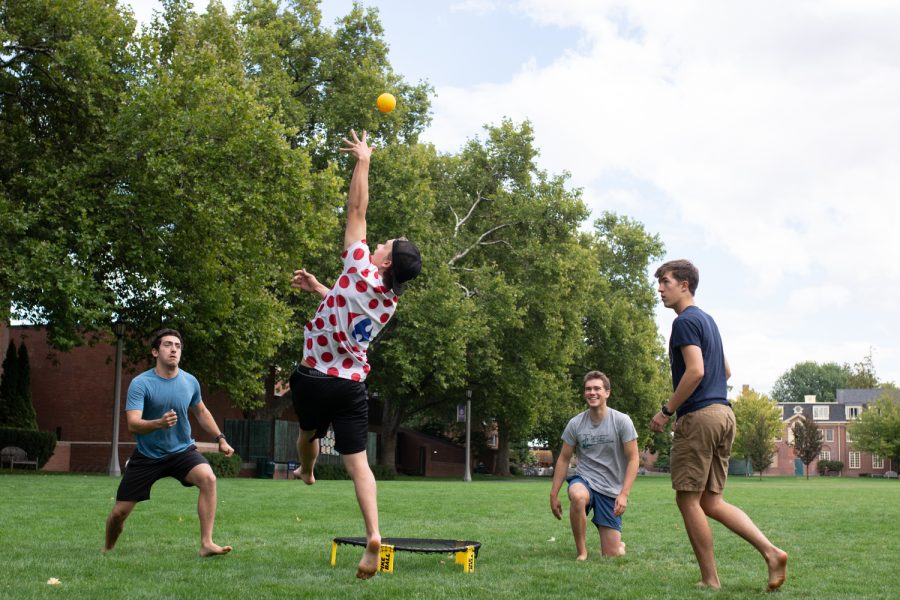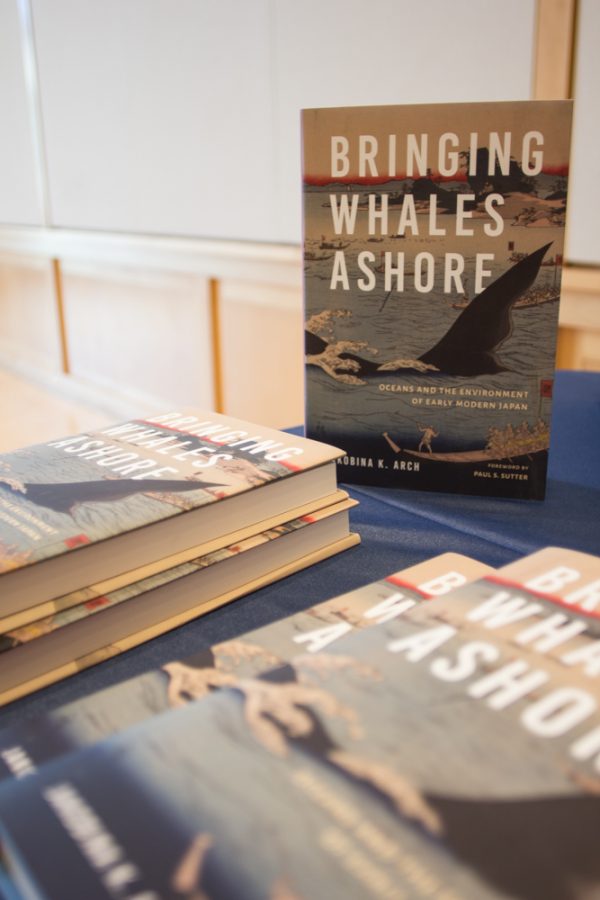6/5 I made it to Nishi Kanazawa station this morning without a hitch! Fool me once, and all. I was wearing my bright, ruffly floral dress in anticipation of the formal meeting at the Prefectural Government Office, and I felt like a fish swimming in the wrong school among all the demurely uniformed high school students commuting to class. I heard the word “gaijin” (foreigner) several times as I passed. Something I found mildly irritating about Japanese society is that since Japan is almost totally racially homogenous, the Japanese will point, stare, and whisper when a foreign person passes. This feeling of annoyance might be a result of living in the ethnically diverse United States, but even growing up in a predominantly white community, I have always known better than to point and shout, “Hey, a black guy!” should an African-American man happen to pass by, for example.
At Rifare, I discovered that I had been enrolled in the third-year Japanese class, which was what I had been hoping for. My excitement at attaining my goal quickly turned to anxiety and shame, however, when we had our first class meeting and I realized how advanced the other third years were. They all knew so much more kanji than I did (about half the class is comprised of native Chinese speakers, who obviously have the upper hand when it comes to writing in Chinese), and a quick “review session” of grammar I had never learned depressed and worried me. Maybe I’ve bitten off more than I can chew with this competitive, intense program.
I was feeling a little down all throughout class and lunch (salad again, this time with spicy dressing), as I was contemplating asking Makino-sensei whether I could move down a level and repeat the second year, as there is just so much I don’t know. After I had eaten, I felt a little better though, and after talking with some of the other students I felt reassured that I had been placed in the correct level. “They don’t make mistakes,” one girl asserted, “they” meaning the PII professors who evaluated our tests.
I won’t bore you with a summary of the visit to the Prefectural Government Office, as it was just as dull as I had predicted. The Prefectural Governor and the Head of the Tourism Bureau seemed like really nice and enthusiastic people, but they made pretty long speeches and I was tired from the morning’s mentally exhausting class. I did find out, though, that Kanazawa is the center of manufacture for those conveyer belt affairs you sometimes see at sushi restaurants.



I walked with a small group of Harvard students from the Prefectural Government Office to a “Best Buy”-type store where I bought a converter (I accidentally brought my three-prong plug for my laptop, which does not work with Japan’s two-prong outlets). Harvard and Princeton are by far the best-represented schools in PII with 11 and 16 participants this year, respectively. Not only am I the sole Whitman student participating in PII, but I’m also the only student attending a school on the West Coast! I can attest that, at least in this particular group of students, the stereotype that East Coasters dress more formally than West Coasters is an exaggeration at best. I was really surprised by how casually some of the students dressed for our governmental visit.
Tonight’s dinner: spaghetti. Ha-chan and Re-chan have recently discovered the “brick-breaker” game on my cell phone and constantly ask if they can play it. I (perhaps mistakenly) showed them PhotoBooth on my Mac in an attempt to distract them and reclaim my phone, and we spent at least an hour taking pictures. I have a feeling that I’ll be hearing repeated requests for PhotoBooth over the next two months. Ha-chan is very gregarious; he invites me to join him in a game of Hot Wheels or building blocks with “Asobou yo!” (“Let’s play!”). Re-chan, true to form, was more reserved, but PhotoBooth brought out his tech-savviness (at 5, he already has a cellphone and enjoys playing its many ringtones for me). By the end of the evening, he was sitting on my lap and demanding that I teach him how to operate PhotoBooth. Ai-san took advantage of the boys’ distraction to make a lengthy phone call upstairs. I know she has a boyfriend that the boys haven’t met yet and that she has limited time to herself, so I was happy to play with the Ha-chan and Re-chan while she went upstairs to take the call. However, I hope this doesn’t become a usual thing, because I have a feeling that my homework load is going to skyrocket before too long. PII crams a year’s worth of study into 2 months, after all.
6/6 The second day of classes was better than the first. Not only was I able to understand more in class, I also received word that I have been selected for an assistantship with a longitudinal survey that the Whitman College Office of Institutional Research and President’s Office will begin next year. This lightened my spirits considerably, and so throughout the day it was as though that Chumbawumba song was on repeat in my head: “I get knocked down, but I get up again. You’re never gonna keep me down!”
In class today we investigated homareru (to receive praise) and kensonsuru (self-effacement or acting humble). As I mentioned before, in Japan when someone praises you for your language ability, you’re supposed to reply “Mada heta desu” (I’m still unskilled) and then possibly elaborate by saying something along the lines of “The only reason I can say anything at all is because I’ve had such great instructors,” or “I can never manage to express the things I want to express in a comprehensible manner.” Even if it means telling lies or pretending that you have absolutely no self-confidence, it’s important to engage in kensonsuru in Japan in order to appear modest.
We didn’t have an afternoon activity today, so after lunch I went to the Rifare library to do my homework until 5:00 when I meet Ai-san at Duffer, her workplace, and we return home together. The homework itself wasn’t particularly demanding; we had to underline noun modifiers, which I actually kind of enjoy doing. However, these modified nouns were embedded in two pages of text jam-packed with kanji I didn’t understand. It took me almost four hours to read one page, as I had to stop and look up the unknown characters in an online dictionary. Looking up kanji can be an especially arduous process if you don’t know how the character is pronounced, so this afternoon I looked for a lot of kanji using radicals, which denote the semantic or functional class of a Chinese character. For example, in the character 金, meaning “gold” or “metal,” the roof-like strokes at the top of the character constitute the radical.
Deciphering the text was a difficult and tiring process, and I found myself cursing the ancient Japanese bureaucrats who adopted a writing system from a country whose linguistic structure had absolutely nothing in common with their own. For a period of time in the days of ancient Japan, the Japanese copied essentially everything their Chinese neighbors did, from religion to architecture to written script. At the time, the Japanese had no written language, only a spoken language. The Japanese decided to adopt the Chinese pictographic script, regardless of the fact that the Chinese written language did not correspond whatsoever to the Japanese spoken language. It was a decision that would ever after invoke the ire of Japanese language students worldwide (with the exception of Chinese students, who are obviously crackerjack at kanji).
The text itself described the Japanese education system, which isn’t the most thrilling topic imaginable but nevertheless included some interesting tidbits of information. For example, the characters describing Japan’s notoriously competitive university entrance exams, å—験戦争 (jukensensou), translate literally as “exam war.” Another phrase, å—é¨“åœ°ç„ (jukenjigoku)ã€translates as “examination hell.” A Japanese student’s life sounds pretty rough, with so much hinging on a couple crucial exams. In the United States, a poor SAT or ACT score doesn’t necessarily mean that one can’t go to college, but in Japan, where application fees are very high and a student can apply to only one or maybe two colleges, entrance exams are very important.
Now I’m finally caught up with my posts (it helps that we’re usually a day ahead here)! If you have any questions about the PII Program, Kanazawa, or Japan in general, please don’t hesitate to post a question in the comments section below.







